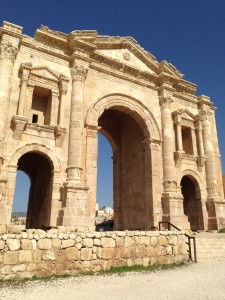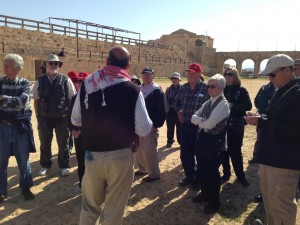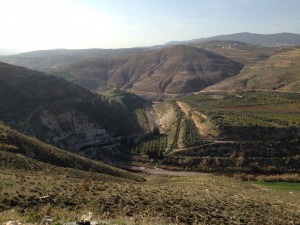Jordan Trip – 5
Yesterday, we retraced Jesus’ steps in Galilee over a brief three-year period of time in the first century. Today, we crossed into new territory. We were like biblical time travelers, spanning centuries of tribal history in just a few hours.
At 9:00 a.m. we crossed into the Hashemite Kingdom of Jordan at the Sheik Hussein Bridge. After passing through customs, we traveled to the region of the Gerasenes. You will recognize this place from Mark 5, when Jesus cast demons out of a man afflicted with so many that he called himself, “Legion.”
This place is home to the ancient city of Jerash, one of the 10 cities of the Decapolis. During Jesus’ day, it was an independent Greek city state that had been conquered by the Romans. Thirty percent of the city is still intact, including Hadrian’s Gate, the town square, a produce market, fountain square, main street (cardo), and a fifth century Byzantine church. It’s an incredible find right in the heart of a bustling area of modern Jordan. I taught on the significance of Jesus’ exorcisms and Jesus’ miracle of feeding 4,000 Gentiles.
After our own version of the feeding at lunch, we boarded the bus for a four-hour ride to Petra, the capital of the ancient Nabateans. On the way, we stopped at an overlook to see the Jabbok River, famous for Jacob’s wrestling with the man of God (Genesis 32:22). He named this place Peniel because he saw God face to face and lived. Here the man of God changed Jacob’s name to Israel. Unlike Jacob, we left that place with our hips still intact.
As we traveled south, we passed through the land of the ancient Ammonites, present-day Amman, the capital of Jordan. We crossed into Ruth’s home tribal land of Moab. Our hotel is located in Wadi Musa, literally “The Valley of Moses,” named for the biblical prophet who led the Israelites in this valley through the wilderness. After arriving at our hotel, we enjoyed a delicious meal of chicken, lamb, fish, and a variety of salads.
This kind of travel day reminds you that so often history gets reduced to generalities. Empires fall, but only the living God remains. Percye Bishe Shelley reflected on the fleeting nature of empires and life when he wrote a sonnet about a traveler from the future observing a statue of Egyptian Pharaoh Ramses 2. The poem is entitled “Ozymandias.”
I met a traveller from an antique land
Who said: Two vast and trunkless legs of stone
Stand in the desert. Near them, on the sand,
Half sunk, a shattered visage lies, whose frown,
And wrinkled lip, and sneer of cold command,
Tell that its sculptor well those passions read
Which yet survive, stamped on these lifeless things,
The hand that mocked them and the heart that fed:
And on the pedestal these words appear:
“My name is Ozymandias, king of kings:
Look on my works, ye Mighty, and despair!”
Nothing beside remains. Round the decay
Of that colossal wreck, boundless and bare
The lone and level sands stretch far away
We travelers are passing through a land and reflecting on empires fallen long ago. The only source of life and sustenance is the God who provided manna for Israelites in this wilderness and distributed the bread of life to demoniacs and crowds. He is the only one who remains. Centuries from now, what will travelers say about us? About you?






